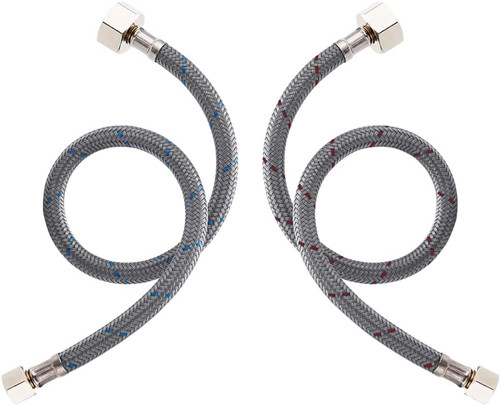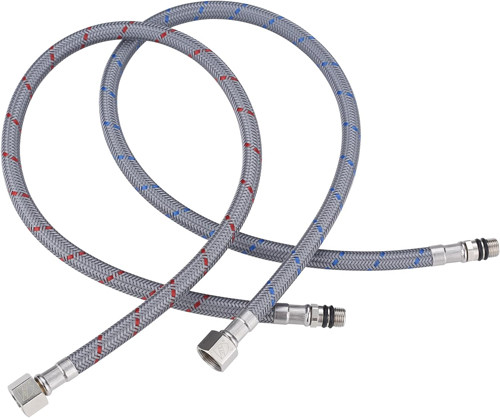
Faucet supply lines play a pivotal role in maintaining a seamless water flow within your plumbing system. However, encountering supply lines that are excessively long can lead to a cluttered and less efficient installation, particularly under the sink. Faucet supply line too long? In this comprehensive guide, we’ll explore the importance of accurate measurements, step-by-step instructions on shortening faucet supply lines, and additional tips to ensure a successful and professional-looking plumbing setup.
Measuring the Supply Line
Before embarking on the task of shortening a faucet supply line, precision in measurement is key. Here’s a detailed guide on how to measure your supply line accurately:
- Turn Off the Water: Begin by shutting off the water supply to the faucet to prevent leaks or spills during the measurement and adjustment process.
- Release Pressure: Open the faucet to release any remaining water pressure in the lines, creating a safer and cleaner work environment.
- Identify Excess Length: Examine the existing supply line to identify the portion that exceeds the required length. While leaving a little extra for flexibility is acceptable, excess length can lead to a cluttered and less efficient installation.
- Measure Twice: Use a measuring tape to measure the exact length needed for the supply line, considering the distance from the shut-off valve to the faucet connection. Double-check your measurements to avoid errors.
Shortening the Supply Line

Once you have precise measurements, you can proceed with shortening the supply line. Follow these additional steps for a smooth and effective process:
Gather Your Tools:
In addition to the previously mentioned tools, consider having a bucket or towel to catch any water drips and a flashlight to illuminate the work area if needed.
Consider Pipe Material:
Identify the material of your supply line (copper, braided stainless steel, etc.) as this can influence the cutting method. For copper, a pipe cutter is ideal, while a hacksaw may be suitable for other materials.
Mark the Cutting Point:
Use a marker to clearly indicate the point on the supply line where you will make the cut. Ensure the mark is visible and accurate, and take into account the type of pipe cutter or saw you’ll be using.
Cut the Supply Line:
If using a pipe cutter, ensure it is properly positioned over the marked point and rotate it until the cut is complete. If using a hacksaw, make a straight and clean cut at the marked point.
Deburr the Cut End:
Remove any sharp edges or burrs from the cut end using a pipe deburring tool or sandpaper. This step ensures a smooth and secure connection.
Apply Teflon Tape:
Wrap Teflon tape around the threads of the cut end to create a watertight seal when reconnecting the supply line.
Reconnect the Supply Line:
Use an adjustable wrench to reconnect the shortened supply line to the shut-off valve and faucet connection. Ensure all connections are tight to prevent leaks.
Turn On the Water:
Gradually turn on the water supply and check for any leaks around the newly adjusted supply line. Tighten connections if necessary.
Additional Tips for Faucet Supply Line Too Long

To elevate your DIY plumbing project and achieve a professional finish, consider the following tips:
- Label and Organize: If you’re working on multiple supply lines, label each one to avoid confusion during reconnection. Organize tools and materials to streamline the process.
- Upgrade Supply Lines: If your existing supply lines are outdated or showing signs of wear, consider upgrading to braided stainless steel lines for enhanced durability and flexibility.
- Check Local Codes: Before making any adjustments, familiarize yourself with local plumbing codes to ensure compliance with regulations.
- Inspect Surrounding Components: Take the opportunity to inspect other plumbing components under the sink, such as the P-trap and connections, and address any issues.
Conclusion
Shortening a faucet supply line is a manageable task that, when done correctly, enhances both the aesthetics and efficiency of your plumbing system. By combining precise measurements with the step-by-step instructions provided, you can confidently undertake this DIY project. Moreover, incorporating additional tips ensures a professional finish, making your plumbing setup not only functional but visually appealing. Always prioritize safety, turn off the water supply, and double-check your measurements to achieve the best results in your DIY plumbing endeavor.
 WOWOW Faucets
WOWOW Faucets



